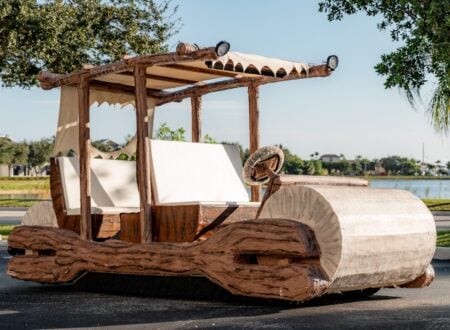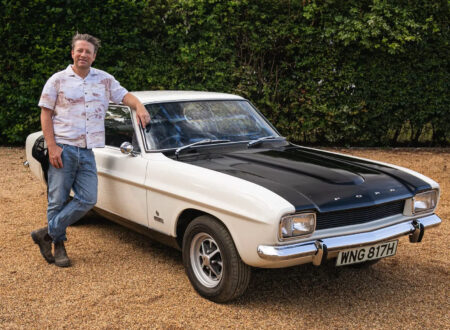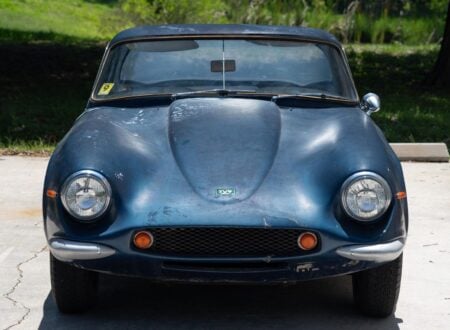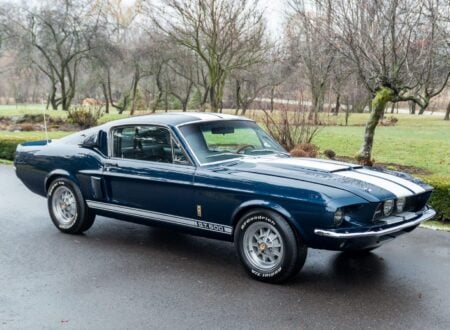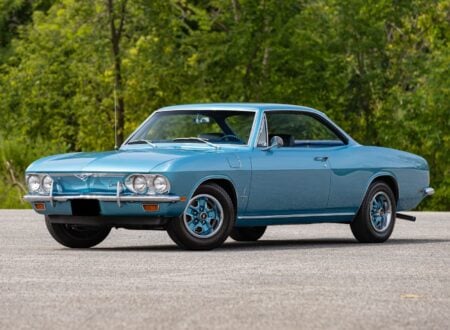The Chevrolet Corvair stands out as one of the most likely candidates for the title of “most controversial American car of the 1960s.”
It may never have become quite so iconically controversial had it not been the subject of the first chapter of activist Ralph Nader’s book “Unsafe at Any Speed“, but back in the 1960’s the American public was not so used to political activism, and many were perhaps less willing to critically examine ideas put forward by activists.
The news media similarly were seemingly happy to put forward ideas that might attract audience ratings and the advertising revenue that generated. Nader put the Chevrolet Corvair in the first chapter of his book and that first chapter was possibly the only one read by journalists putting together a story with a deadline to meet.
The result for the Chevrolet Corvair was its being plastered with negative publicity that ultimately helped seal its demise, despite the fact that at the time of the publication of Nader’s book, 1965, the criticisms he had levelled at the Corvair had been remedied in the new Second Generation models released that same year.
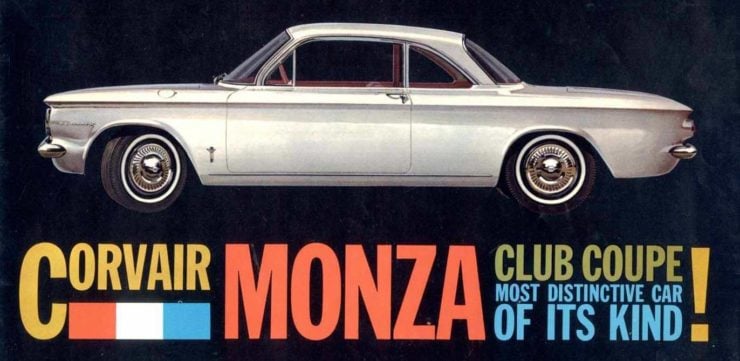
Background: The Creative Era of the 1950’s and 1960’s
The years after the end of the Second World War were creative years. People in the United States had fought for freedom and won, and many had obtained new levels of financial security with the ability to own an automobile and enjoy the freedom that provided. Vehicle makers were quick to capitalize on people’s willingness and ability to buy a car to the extent that they wanted people to trade in their car every year or two for a new model: something that was to challenge a lot of people’s bank balances.
In this new creative era makers experimented with all sorts of new ideas. British car maker Rover had been instrumental in the development of the jet engine and gas turbine and did a lot of work developing and evaluating gas turbine technology for powering passenger cars – remember that this was the era of the creation of the supersonic Concorde and the era of the space race. American car makers Ford and Chrysler both tried gas turbines in automobiles with the Chrysler one becoming famous as a car that could run on Tequila.
Not only were makers looking at alternative types of engine for automobiles but also new design concepts. Prior to the beginning of the Second World War the Germans had embarked on a project to enable every German family to own a “People’s Car”. The design work had been done by Dr. Ferdinand Porsche with collaboration with fellow Austrian Hans Ledwinka.
Both Porsche and Ledwinka were keen on the idea of a four seater car powered by a rear mounted air cooled engine and so that its what the “KDF Wagen”, which later became known as the “Volkswagen” was based on. This design concept was also used by other German auto makers during the 1930’s such as Mercedes. The use of this design, which had some inherent limitations, was in all probability done at the behest of Adolf Hitler himself who was very interested in cars although he could not drive one.

Both the Volkswagen and the Hans Ledwinka designed Czechoslovakian Tatra 77 and later Tatra 87 used a rear engine with independent rear suspension using swing axles. The Tatra 77 and 87 did not just hang a lightweight horizontally opposed “boxer” engine behind the back axle line however, they had a 3.0-3.4 liter alloy V8.
These big Tatra V8 cars were made from 1934 onward and became rather popular with some of Hitler’s senior officers until it was found that the rear mounted V8 engine with swing axle combination had a tendency to switch into savage oversteer during enthusiastic cornering resulting in the car doing a roly-poly into the shrubbery often causing the expiry of the Nazi officer doing the enthusiastic cornering. The car was dubbed “The Czech secret weapon” and Hitler banned his senior officers from owning them.
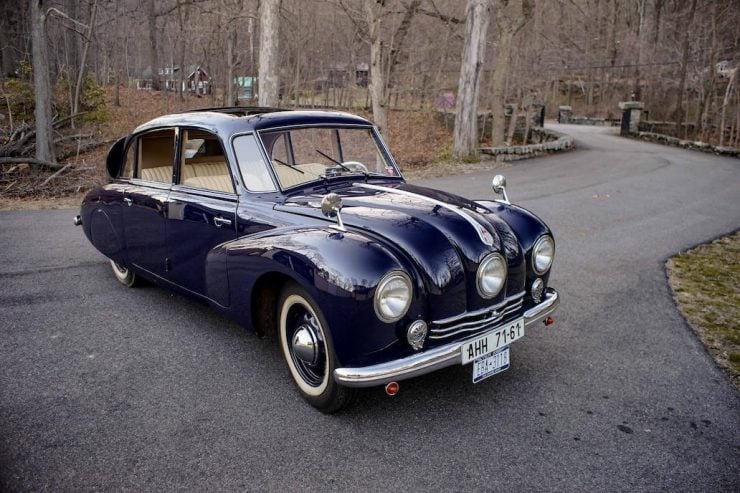
The upshot of all this is that the inherent problems associated with a rear mounted engine using a swing axle suspension were well known by the time General Motors decided to build a modest sized rear engine car using swing axles.
The Chevrolet Corvair is Born
Although some may wonder “What were they thinking” when General Motors decided to create a new car with a rear mounted engine we need to realize that by the late 1950’s both the rear engine Volkswagen and Porsche 356 had established excellent reputations for themselves, and that Tatra also had gained a great deal of motor sport success with their Tatra 603, the much improved successor to the Tatra 77 and 87 that had proved so adept at killing Nazis.
The rear mounted horizontally opposed engine was also ideal for buses and it provided the advantage of a flat floor in the passenger compartment, something that could be achieved by either a front engine with front wheel drive, as would later be done for the GMC Motorhome, a front engine with a fixed tube to transmit power to the rear wheels, which would have to use an independent rear suspension (i.e. the 1947 Chevrolet Cadet concept car), or a rear engine with rear wheel drive. General Motors decided to go with the layout that had proven so successful for Volkswagen and Porsche.
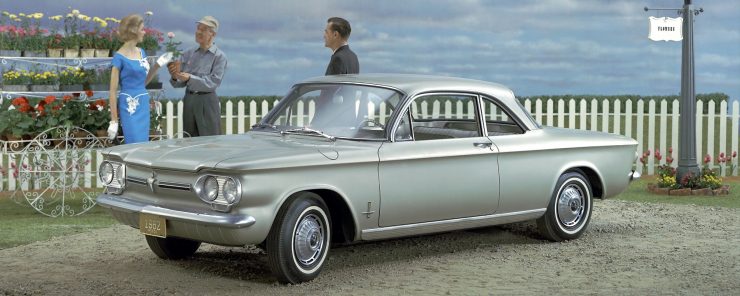
General Motors was an international company and already owned Vauxhall in Britain, Opel in Germany, and Holden in Australia. All three of these markets required the manufacture of what would be considered compact cars in the United States, yet these compact cars, such as the Australian GM Holden models of the 1940’s and 1950’s, were six seater automobiles. So GM already had models which they could manufacture in the US or import to provide a compact car model for the US market. But Ed Cole, who was Vice President of General Motors and General Manager of Chevrolet wanted to create a new and unique model to fill the compact car market segment.
Ed Cole had been involved in the building of tanks during the Second World War but it was in 1950 when he was in charge of production of the M41 Walker Bulldog tank that he most likely began thinking about using an air cooled engine for a passenger car. The M41 Walker Bulldog was powered by Continental horizontally opposed six cylinder boxer air cooled engine. Ed Cole also extensively flew a Beechcraft Bonanza aircraft which was fitted with a Continental boxer air cooled engine and so he developed a great respect for the reliability of this engine type.
The vision for the new Chevrolet for a new era was for it to have an aircraft like horizontally opposed air cooled engine made of aircraft grade aluminum alloy and mounted in the rear with the gearbox and differential as a single integrated “Unipack” unit. The car was to be kept low to give it a lower center of gravity and to give it sports car sleekness. Ed Cole wanted a Chevrolet that would stand out from the opposition by having European handling, improved reliability, and a flat floor in the passenger compartment. He seems to have envisioned something like an American six seater Porsche.

First Generation Chevrolet Corvair (1960-1964)
The Ed Cole vision may have worked perfectly but for the fact that the Corvair was initially made to be an inexpensive compact car, sort of like a Chevrolet “Volkswagen” but offering a lot more carrying capacity than the Volkswagen.
Making the car inexpensive however meant that costs had to be minimized and so for the early cars some engineering that should have been done wasn’t. But this was covered by the stylish bodywork on the car that made it “look like a million dollars” as one period reviewer remarked.
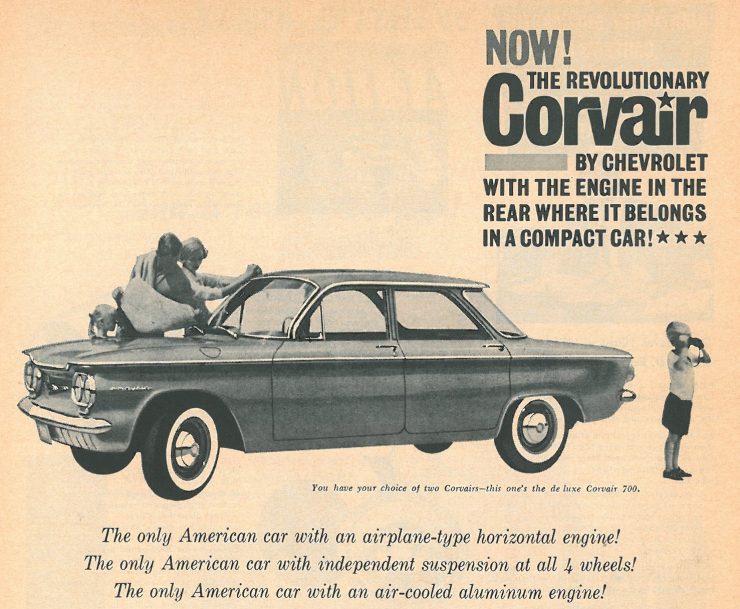
The initial plan for the Corvair had been for a four cylinder boxer engine with high-silicon aluminum cylinders. This design would have kept the weight down, but it was decided that the four cylinder was not as smooth as a six and so the car’s engine was made to be a six cylinder, projecting more weight behind the rear axle line. The high-silicon aluminum cylinders were also abandoned in favor of cast iron ones, further increasing the weight. The result was an engine weight of 332lb, which was 78lb more than originally intended.
To mitigate against this Chevrolet put the spare tire in the front of the car and also had the fuel tank there. They chose not to have the battery in the front to help with weight distribution however but instead installed it in the rear.
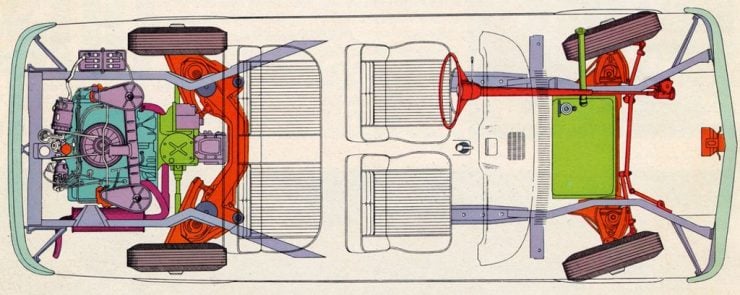
The Corvair was intended to provide a comfortable ride despite its smaller size. Americans were used to cars with very soft suspension, cars that gave you a feeling that you were floating along the road. To this end the Corvair was designed with fully independent suspension front and rear. At the front were conventional anti-dive wishbones with coil springs, while at the rear were semi-trailing arms with coil springs. Brakes were servo assisted hydraulic drums all around and steering was by worm and roller.
In keeping costs down GM decided not to use a front anti-roll bar and also, more critically, chose not to use a camber compensating leaf spring at the rear which would have been installed bolted to the transmission and to the suspension arms on both sides. The camber compensating spring was a popular accessory on the after-market for Volkswagens and Porsches and became a standard fitting on Porsches to mitigate the propensity of the swing axle to “tuck under” in cornering, especially if braking in a corner. It did not take long for EMPI to start making a kit for the Corvair also.
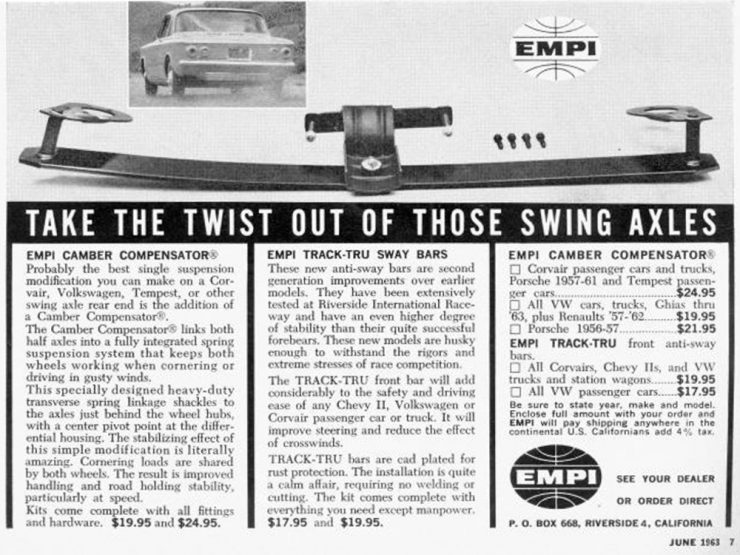
The Corvair used a unibody and was the first such car made by Fisher. The styling was intentionally quite European in style with no pronounced fins or similar such stylistic devices. The car was made in four body styles; first produced was the four door sedan, followed by the two door Monza coupé, the Lakewood station wagon, and later in 1962 the convertible.
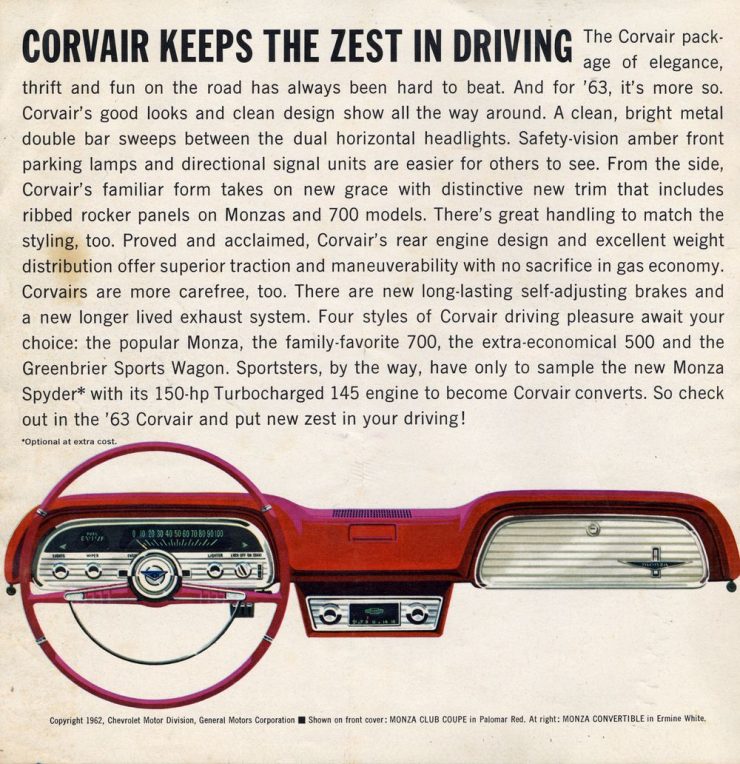
Weight distribution for the early Corvairs was 36% front to 64% rear. In 1961 this became even more uneven when the spare tire was relocated from the front to the rear of the car. Given the cars propensity for oversteer, which could sometimes cause it to swap ends and go for an off road excursion rear first, Chevrolet decided that the cheapest and easiest “fix” would be to tweak the tire pressures.
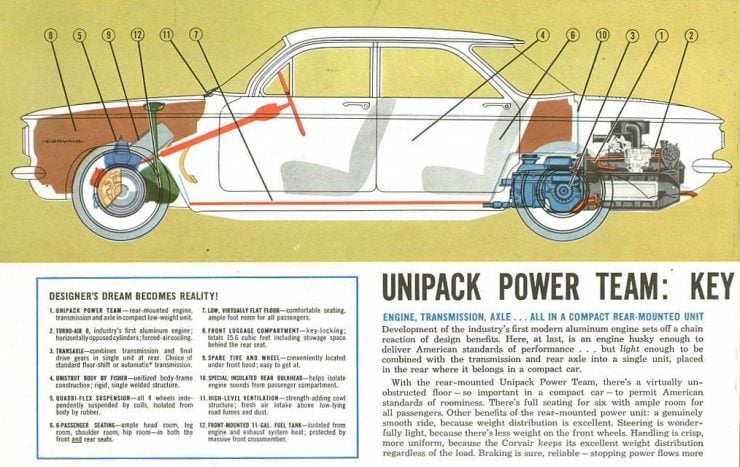
Chevrolet specified front tire pressures of 15 psi, and rear tire pressures of 26 psi (cold). These 6.50 x 13″ tubeless tires would typically be inflated to pressures in the 24 psi to 28 psi range in a car with even weight distribution: so 15 psi at the front was very low, and 26 psi at the rear still left the tire overloaded.
Also worth considering is that if you took a car fitted with tubeless tires to the race track in the 1960’s you would be expected to fit tubes in the tubeless tires to help mitigate against sudden deflation caused by cornering forces pressing the tubeless tire just a little from the rim breaking the air seal. Corvairs became known for rear outside tire deflation if they were in the process of going sideways, something that could result in a reenactment of a Tatra 77 going roly-poly.
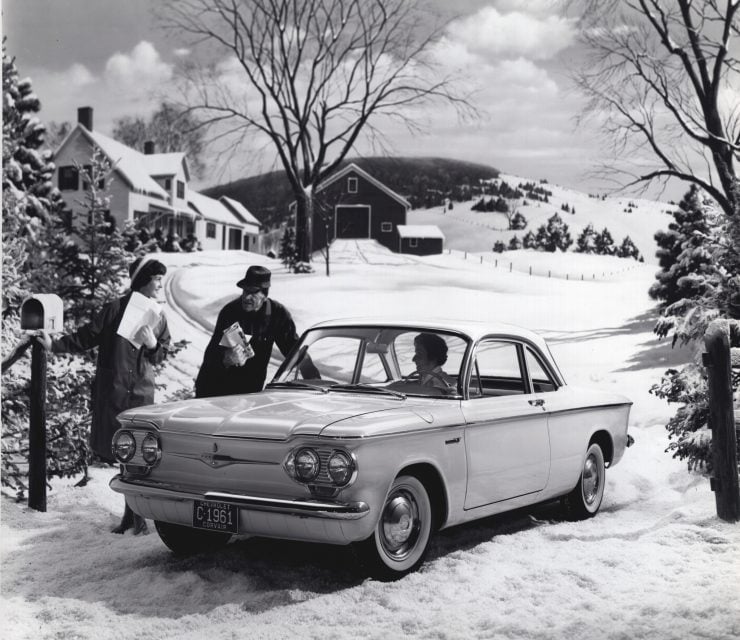
The people who bought a Corvair were not so likely to want to test the car’s limits however. Most customers were people whose driving would be quite pedestrian and who would not be likely to run into the sudden and severe swap into extreme oversteer unless they were faced with an emergency: doing emergency braking in a corner at highway speeds to avoid an obstacle such as an animal for example.
Indeed in the 1950’s and 1960’s drivers generally were not particularly aware of technical features that would make a car safer: the main thing in the car that ensured its safety was the driver, and it still is. So a Corvair driven competently was a safe enough automobile for most people. This was still an era when drum brakes were almost universally fitted, with disc brakes being a relative rarity just beginning to be fitted on sports cars.
Similarly the three point seat belt was invented in 1959 by Nils Bohlin of Volvo and then offered to the world by Volvo for free with no patent or licensing, though it would take over a decade for three point seat belts to become a standard fitting on passenger cars, and rather longer for ordinary people to be persuaded to wear them.
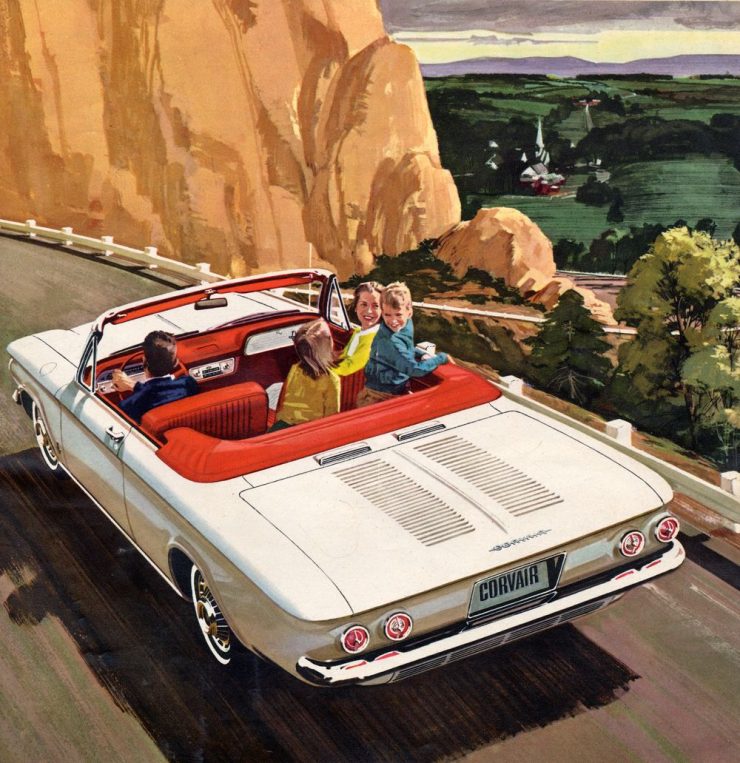
The options available for the Corvair 579 standard model were the two speed Powerglide automatic suspension, a gasoline heater, and an AM tube/valve radio (transistors were still a new thing in 1960). A folding rear seat became standard in 1960 to help mitigate the lack of storage space.
The car was sold in standard 569 and deluxe 769 versions. In 1960 the the 527 and 727 coupé models were introduced also followed by the 900 series Monza coupé which was made with front bucket seats. By 1962 GM were taking notice of customer and motoring press feedback regarding the handling of the Corvair and introduced an uprated suspension option pack for the Monza, Monza Spyder convertible, and four door sedan models.
This package included metallic brake linings, a front anti-roll bar, rear-axle travel limit straps, revised spring rates, and re-calibrated shock absorbers. This did much to mitigate the car’s handling problems and the criticism associated with it.

In 1964 the general production car’s suspension was revised with the fitting of a front anti-roll bar as standard and also the fitting of a camber compensator leaf spring at the rear. The car’s brakes were also upgraded by the fitting of finned drum brakes at the rear, this being because the front to rear braking ratio had to be set at 46% front and 54% rear to compensate for the car’s rear heavy weight distribution.
Second Generation Chevrolet Corvair (1965-1969)
The Second Generation Chevrolet Corvair was released in 1965, the same year as Ralph Nader’s book, and it addressed the weaknesses of the first generation Corvairs decisively. Gone were the rear Volkswagen style swing axles to be replaced by double jointed drive shafts as used in the Corvette: this ensured the rear wheels would not “tuck under” under extreme braking in a corner. The difference between the first and new second generation cars is summed up by Car and Driver magazine’s David E. Davis Jr. writing the the October 1964 issue as follows:
“And it is here too, that we have to go on record and say that the Corvair is — in our opinion — the most important new car of the entire crop of ’65 models, and the most beautiful car to appear in this country since before World War II.” “When the pictures of the ’65 Corvair arrived in our offices, the man who opened the envelope actually let out a great shout of delight and amazement on first seeing the car, and in thirty seconds the whole staff was charging around, each wanting to be the first to show somebody else, each wanting the vicarious kick of hearing that characteristic war-whoop from the first-time viewer.”
“Our ardor had cooled a little by the time we got to drive the cars — then we went nuts all over again. The new rear suspension, the new softer spring rates in front, the bigger brakes, the addition of some more power, all these factors had us driving around like idiots — zooming around the handling loop dragging with each other, standing on the brakes — until we had to reluctantly turn the car over to some other impatient journalist … The ’65 Corvair is an outstanding car. It doesn’t go fast enough, but we love it.”
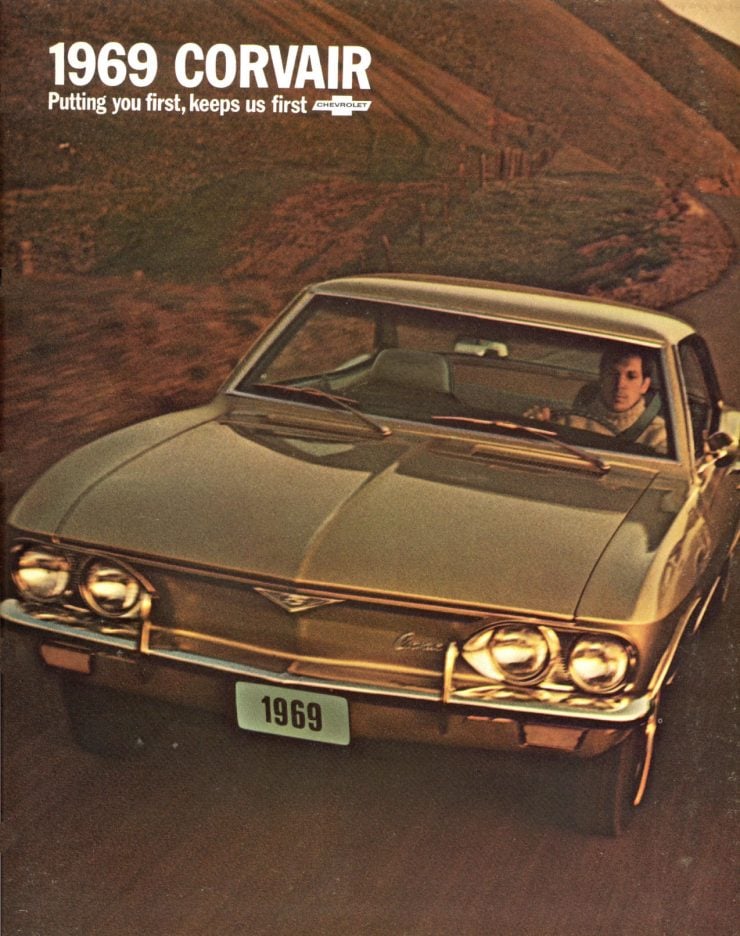
Suddenly the Corvair had morphed into the car that Ed Cole had envisioned a decade earlier. It had become a car that could compete with the Ford Thunderbird, especially in Corvair Monza form. The body styling was new and much improved, having a more graceful yet purposeful look.
The car looked like something that could have been designed in Italy and its performance proved to be nicely improved not only by virtue of its new suspension, but also because of engine upgrades.
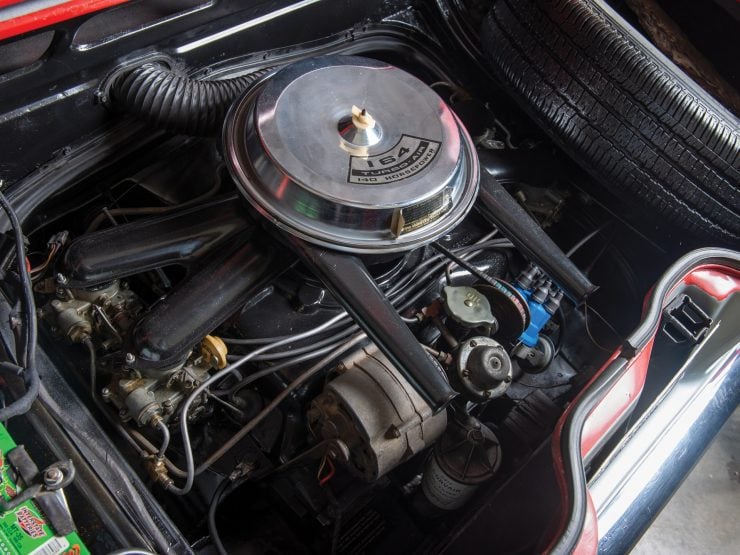
The engines for the new generation Corvair still carried forward the 95hp and 110hp from the previous years first generation for buyers wanting economy, but the Corsa model had a new 140hp version equipped with four single barrel downdraft carburetors, larger valves, and a dual exhaust system. Also available for the Corsa model was a turbocharged 180hp engine along with the option to upgrade from the standard three speed manual gearbox to a four speed all synchromesh unit. The second generation Corvair engines were all improved with some heavier duty internal components originally inherited from the turbocharged engines.
The up market Corsa model also featured a Delcotron alternator to significantly improve the vehicle’s electrics and had air conditioning as an option along with an AM/FM radio, and a telescopically adjustable steering wheel to go with the optional quick ratio steering box which gave the Corvair a rather more direct steering than was common on American cars of the time.
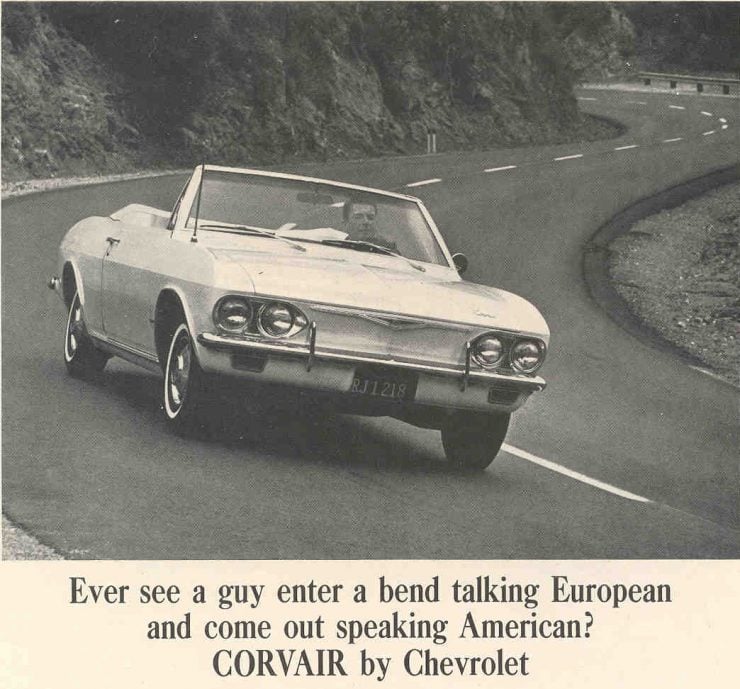
Chevrolet had adjusted its model line-up by 1965. Early in the Corvair’s production it had been realized that the Corvair was not best placed to become a large American “Volkswagen” and so Chevrolet had found the need to create a conventional compact car which was the Chevy II.
The Chevy II was introduced in 1961 and had been all that buyers of a compact car had wanted: it was conventional, everyone knew how to fix and maintain one, and its handling was boringly predictable. The car was developed from scratch in a short eighteen months because it was needed to compete with Ford’s new Falcon, and the Corvair was too different to do that.
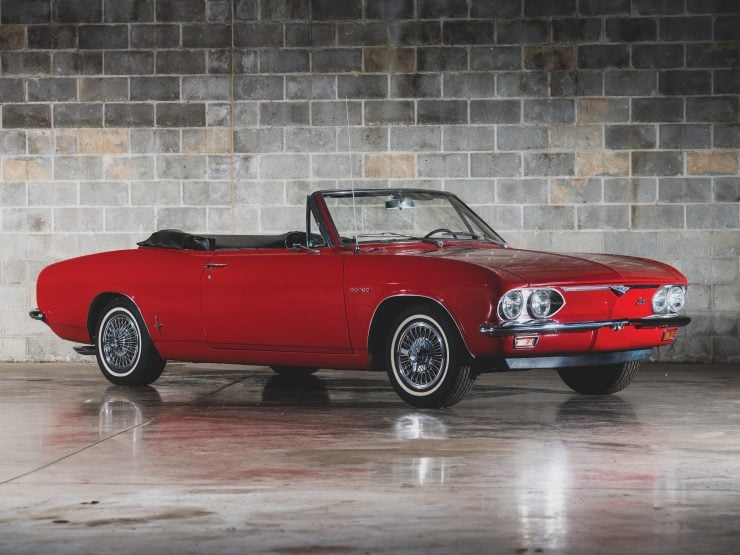
The Corvair however had emerged as a car that had more appeal to buyers who were looking for an exciting and not at all boring driving experience: Chevrolet had recognized this and removed the station wagon and pick-up body styles from the Corvair model line-up. Instead were the Monza and Corsa, interesting, very different, and a tad exotic while being home grown American.
The second generation had a lot going for it but it would be killed off by something that General Motors probably should have seen coming, but didn’t. That thing was actually not Ralph Nader’s book, that did some harm but it was not the killer. The killer was Ford’s new Mustang which was introduced the same year as the second generation Corvair and Nadar’s book and which took America by storm.
The Mustang became an instant American legend and its appearance in the car chase scene in the 1968 movie “Bullitt” cemented its place as a “must have” American icon. Sales of the Corvair fell precipitately and General Motors scrambled to get their own Mustang, the Chevrolet Camaro, into production. Production of the Corvair quietly ended in 1969.
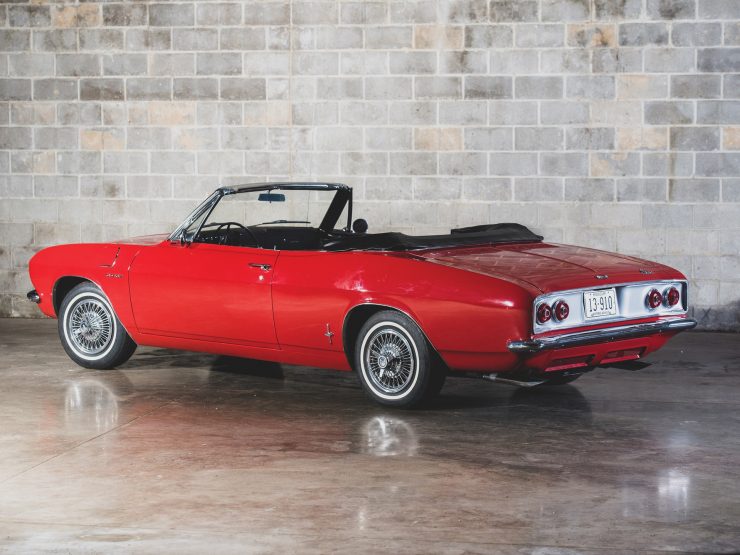
Specifications
Body: All steel Fisher unibody with separate sub-frames front and rear. Length 180″ (457.2cm), width 67.01″ (170.2cm), height 51.5″ (130.8cm), wheelbase 107.99″ (274.3cm), kerb weight 2,449lb (1,111kg).
Suspension and Steering: Front, Independent with “Anti-dive” Wishbones, coil springs and telescopic shock absorbers. Rear, semi-trailing arms with coil springs and telescopic shock absorbers. From 1964 the front suspension was fitted with an anti-roll bar and at the rear a camber compensating spring was added. Steering by recirculating ball.
Brakes: 9×1.75 inch hydraulically actuated drum brakes front and rear with servo assistance. Front to rear braking ratio set at 46% front and 54% rear to compensate for the car’s weight distribution and weight transfer under braking.
Wheels and Tires: 13 inch steel wheels with 6.50 x 13″ four ply tires. Front tire pressure 15psi rear tire pressure 26psi (cold).
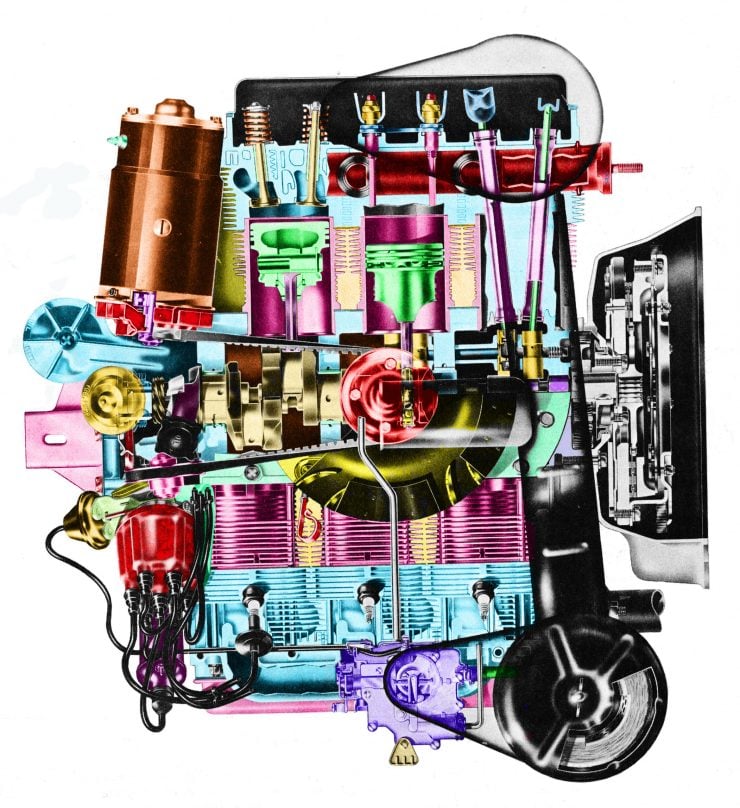
Chevrolet Corvair Engines:
1/: 140 cu. in. (2,296cc) horizontally opposed six cylinder fitted with two Rochester single barrel downdraft carburetors. Compression ratio 8.0:1 with power of 80 bhp @ 5,200rpm.
2/: Optional “Super Turbo Air” upgrade from standard engine produced 95 hp @ 4,800 rpm and 125 lb/ft torque at 2,800 rpm. This engine featured an uprated camshaft, cylinder heads, valves with dual springs, and a lower restriction muffler with a 2″ outlet.
3/: 1962 “Spyder” turbocharged engine option for the convertible and Monza produced 150hp.
4/: 1964 163.971 cu. in. (2,687cc) horizontally opposed six cylinder fitted with two Rochester single barrel downdraft carburetors. Compression ratio 8.25:1 with power of 95bhp @ 3,700rpm and torque of 114lb/ft @ 2.400rpm.
5/: Monza engine: 144.9 cu. in. (2,375cc) horizontally opposed six cylinder fitted with two Rochester single barrel downdraft carburetors. Compression ratio 9:1 with power of 102bhp @ 4.400rpm and torque of 134lb/ft @ 4,400rpm.
6:/ 1965 “Spyder” turbocharged engine replaced by a normally aspirated tuned engine fitted with larger valves, four single barrel downdraft carburetors and a dual exhaust system. This engine produced 140hp.
7/: Corsa Sport Coupé 164 Turbocharged engine: 163.7 cu. in. (2,683cc) Horizontally opposed six cylinder fitted with a turbocharger and single carburetor producing 180hp (SAE gross) with 265lb/ft torque.
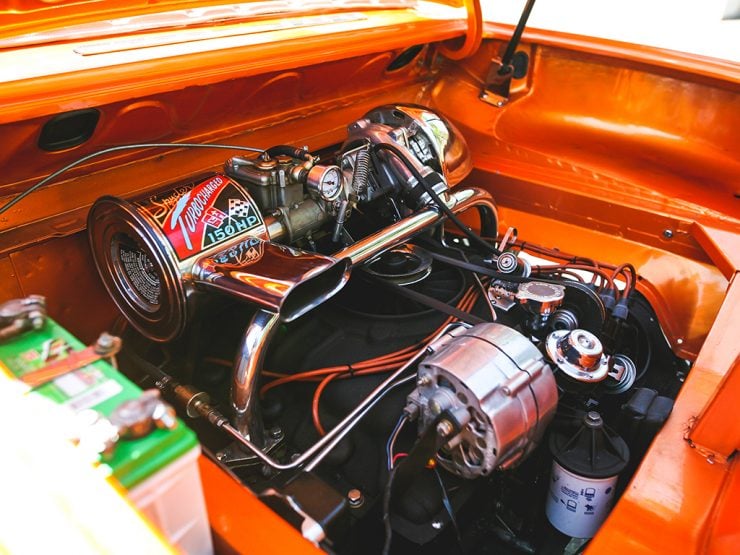
Fuel Tank: 11 US gallons standard. Monza and Corsa Sport Coupé 14 US gallons.
Transmission: Three speed manual gearbox with synchromesh on second and top gears. Optional two speed Powerglide automatic. From 1961 four speed all synchromesh manual gearbox. From 1959-1964 the car was fitted with swing axles and from 1965-1969 the drive axles were double jointed eliminating the handling problems associated with the swing axles.
Conclusion
The old saying tells us that “Wisdom with the benefit of hindsight is the worst kind of wisdom”. When General Motors first embarked on their vision to create a large American Volkswagen they had before them the Volkswagen itself, which was selling amazingly well in the United States and all over the world, and the Volkswagen based Porsche 356.
The handling vices of the Volkswagen were well known but did not seem to be a cause of great concern. The handling of the Porsche 356 was the subject of accolades by sports car aficionados all over the world which seemed to confirm that the rear engine with swing axles would be a perfect car for a Chevrolet for the “swinging sixties”.
When the Corvair first went on sale it sold like hotcakes, people loved it on the showroom floor, they loved the test drive experience with the smoothness of that rear mounted six, they wanted the interior flat floor. It was a car that exuded quality and which had something of an exotic aura about it. The exotic appeal of the Corvair was immediately evident in the first year sales figures: despite the fact that the Corvair had been intended as a compact utilitarian Chevrolet “People’s Car” the base models didn’t sell as well as the deluxe models.
This can be seen in the first year sales figures for the coupé models as an example: sales were 14,628 base model coupés, 36,562 727 deluxe coupés, and 11,926 of the more expensive Monza club coupés. The sales figures tended to indicate that people were buying a Corvair to get themselves an “American Porsche”, or as close to one as they could afford.
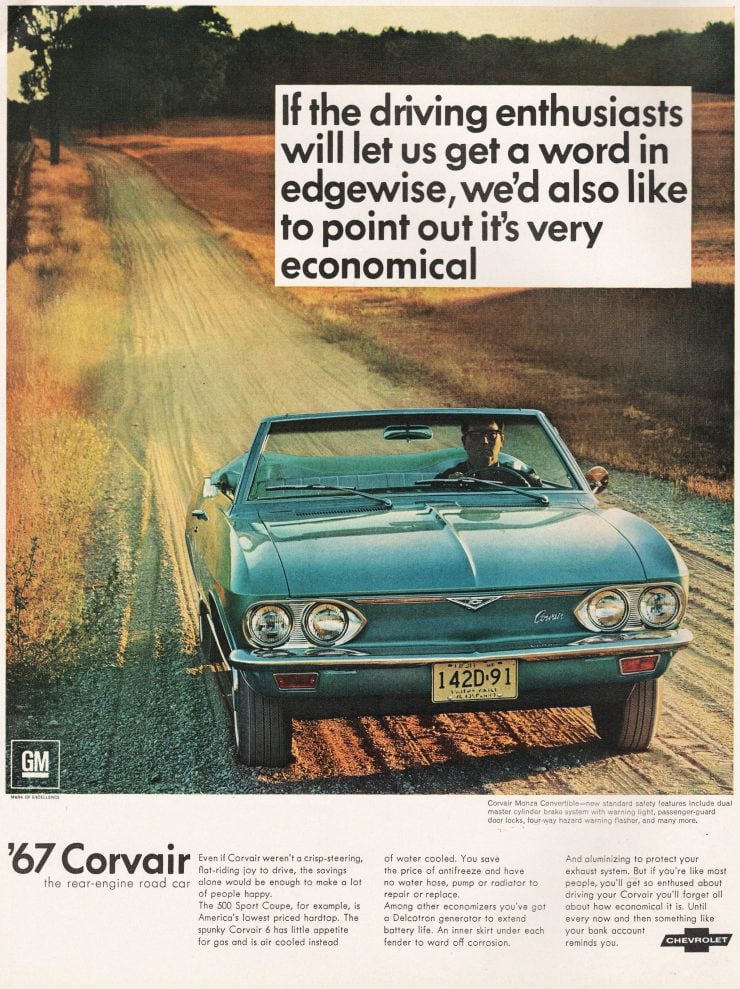
Given this sales pattern Chevrolet progressively moved to build Corvair models for enthusiast drivers and to market the Corvair to that segment. With the introduction of the second generation cars in 1965 Chevrolet had indeed achieved creating a safe and exciting driver’s car: an American car providing European style and driving experience. What would replace it however was an American car, with an American V8 engine, and an unmistakably American driving experience: the Ford Mustang.
Photo Credits: General Motors, Chevrolet, Walter Farynk courtesy of GM, Bonhams, Darin Schnabel courtesy of RM Sothebys.

Jon Branch has written countless official automobile Buying Guides for eBay Motors over the years, he’s also written for Hagerty, he’s a long time contributor to Silodrome and the official SSAA Magazine, and he’s the founder and senior editor of Revivaler.
Jon has done radio, television, magazine, and newspaper interviews on various issues, and has traveled extensively, having lived in Britain, Australia, China, and Hong Kong. The fastest thing he’s ever driven was a Bolwell Nagari, the slowest was a Caterpillar D9, and the most challenging was a 1950’s MAN semi-trailer with unexpected brake failure.

